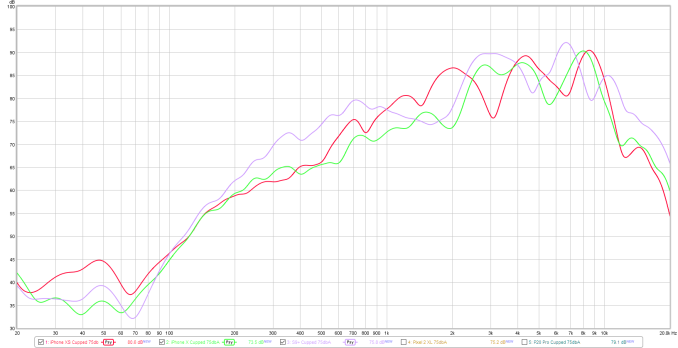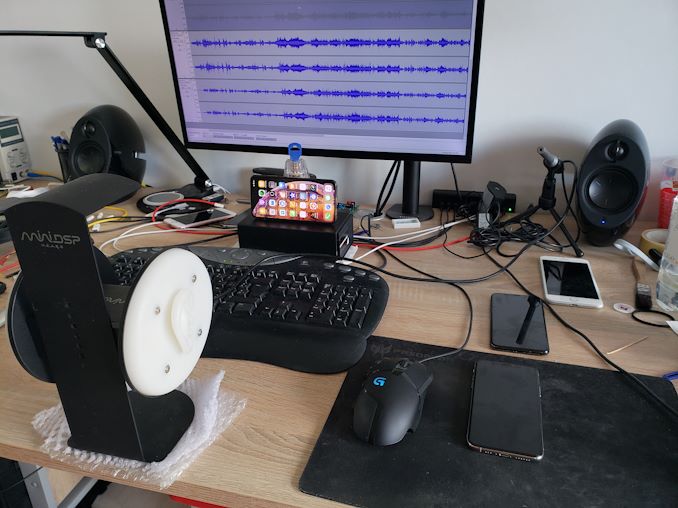The iPhone XS & XS Max Review: Unveiling the Silicon Secrets
by Andrei Frumusanu on October 5, 2018 8:00 AM EST- Posted in
- Mobile
- Apple
- Smartphones
- iPhone XS
- iPhone XS Max
Camera Video Recording
In terms of video recording, the iPhone XS promises an improved dynamic range in modes up to 30fps. What this likely means is that the phone’s able to capture in HDR mode in the 30fps modes, doing the same kind of processing we also see in SmartHDR still pictures.
Also something I’ve dreaded on iPhones for years; the new iPhone XS finally introduces stereo audio recording. Why it took Apple such a long time to finally introduce stereo recording is something that boggles the mind, but, let’s not complain, as we now finally have it on the new generation.
iPhone XS: iPhone X:
Comparing the iPhone XS video to the iPhone X, there’s one thing that is immediately very evident: the new XS is able to produce much better image stabilisation than last year’s flagship. Indeed, it looks like Apple vastly improved the OIS/EIS on the new phones, as the wobble that happens when walking is gone on the XS.
Audio recording finally is up to par, and we can hear the wind and rustling leaves of the trees around us. I think Apple might still have to work a bit on the wind noise cancellation, as in some parts the audio sounded as if it was inside a tube.
In terms of image quality, Apple’s claims of the improved dynamic range are very much verified. The phone showcases a lot more brought down highlights in the scene, and in darker areas, show better shadows. It’s unfortunate that this is limited only to the 30fps modes, but it’s understandable.
Switching over from the main lens to the telephoto lens happens relatively fast, although with a short exposure flash and a slight delay on the first zoom. 4K60 recording doesn’t allow for the use of the telephoto lens.
All in all, the video recording quality of the new iPhone XS is massively improved in all areas of stabilisation, picture quality, and audio. 4K30 recording on the XS is probably the best I’ve seen on any smartphone – a definitive applause to Apple for the improvements here.
Speaker Evaluation
Apple claimed to have improved the speaker audio quality on the new iPhone XS, allowing for more stereo separation and filling sound. I had introduced a new speaker evaluation method a few months ago because this year’s efforts by smartphone vendors to improve speaker quality has been very pronounced, and I wanted to have a way to objectively convey these improvements.
Starting off with speaker loudness, we’re measuring the phones at maximum volume, both in one-hand portrait mode, as well as two-handed mode where the palms are cupped towards the user. These two use-cases are what I find myself most often using the phone’s speakers in, so hopefully that also represents how most users use it as well, please let me know otherwise!

Using a pink noise signal, the iPhone XS pretty much falls into line with the results of the iPhone X, coming in at a very loud 82.8dBA in portrait mode and 87.6dbA in two-handed mode. Apple’s sound directionality on the iPhone X and XS is among the best, most likely due to the fact that the stereo earpiece is among the loudest of current generation smartphones.
Measuring the frequency response of the speakers, we see the iPhone XS closely following the measurement of the iPhone X, however there’s a major difference in the mid-range where the XS is around 5dB louder, raising instrumental frequencies and voices. This difference is what I think Apple is referring to when talking about better “fullness”, as it is evident when playing back media.
To better demonstrate the difference between the phones, I’ve attempted to capture them with a binaural microphone setup. Now I know my environment isn’t perfect as I don’t have the necessary sound dampening equipment, but I hope it does serve as an overall adequate A/B comparison between the phones. I’ve tried to calibrate the sound as much as possible recorded by the setup to a flat frequency response, although I’m sure there are improvements to be made. As a comparison, I also included calibrated speakers as a baseline to get an idea of the microphone setup.
The audio is meant to be listened to with headphones, or even better with IEMs, as this will give the intended playback of the binaural recording.
The iPhone XS’ improvements in the mid-range are quite evident as voices sound deeper and more pronounced on the new phone. Stereo separation is also quite good – resulting in a filling audio experience.
I included the S9+ and G7 as comparison devices. Samsung still does a significantly better job at the low-mid ranges which gives the phone more overall presence than the iPhones, also has an advantage in the very high frequencies giving more clarity, however the new iPhone’s XS strength point in the mid-ranges is the S9’s weakness, and vocals sound a lot less present than on the XS.
As for the G7, I just wanted to showcase a mono speaker device, and just how huge the audio difference is. Unfortunately the G7, even though it promises to have a good speaker, fails in practice.












253 Comments
View All Comments
eastcoast_pete - Sunday, October 7, 2018 - link
Apple's strength (supremacy) in the performance of their SoCs really lies in the fine-tuned match of apps and especially low-level software that make good use of excellent hardware. What happens when that doesn't happen was outlined in detail by Andrei in his reviews of Samsung's Mongoose M3 SoC - to use a famous line from a movie that "could've been a contender", but really isn't. Apple's tight integration is the key factor that a more open ecosytem (Android) has a hard time matching; however, Google and (especially) Qualcomm leave a lot of possible performance improvements on the table by really poor collaboration; for example, GPU-assisted computing is AWOL for Android - not a smart move when you try to compete against Apple.varase - Tuesday, October 23, 2018 - link
I have serious doubts that Android would even run on an A12 SoC - I thought Apple trashed ARMv7 when it went to A11.Strafeb - Saturday, October 6, 2018 - link
It would be interesting to see comparison of screen efficiency of iPhone XR's low res LCD screen, and also some of LG's pOLED screens like in V40.Alistair - Saturday, October 6, 2018 - link
The Xeon Platinum 8176 is a 28 core, $9000 Intel server CPU, based on Skylake. In single threaded performance, the iPhone XS outperforms it by 12 percent for integers, despite its lower clock speed. If the iPhone were to run at 3.8ghz, the Apple A12 would outperform Intel's CPU by 64 percent on average for integer tests.iPhone XS and A12 numbers from: https://www.anandtech.com/show/13392/the-iphone-xs...
Xeon numbers from: https://www.anandtech.com/show/12694/assessing-cav...
spreadsheet: https://docs.google.com/spreadsheets/d/1ipKIh4i56o...
image of chart: https://i.imgur.com/IAupi9p.jpg
Think about that, the iPhone's CPU IPC (performance per clock) is already higher in integer performance now. Those tests include: spam filter, compression, compiling, vehicle scheduling, game ai, protein seq. analyses, chess, quantum simulation, video encoding, network sim, pathfinding, and xml processing. Test takes hours to run.
SanX - Saturday, October 6, 2018 - link
Yes, and while Apple and all other mobile processor manufacturers charge $5 per core, Intel $300yeeeeman - Saturday, October 6, 2018 - link
It might be faster in single thread, but in MT it gets toasted by the Xeon. The Xeon is 9000$ for a few reasons:- it is an enterprise chip;
- it supports ecc;
- it supports up to 8 cpus on a board;
- it supports tons of ram, a LOT of memory channels;
- it has almost 40MB of L3 cache, compared to 8mb in a12;
- it has a ring bus architecture meaning all those cores have very low latency between them and to memory;
- it has CISC instructions, meaning that when you get out of basic phone apps and you start doing scientific/database/HPC stuff, you will see a lot of benefits and performance improvements from executing a single instruction for a specific operation, compared to the RISC nature of A12;
- it supports AVX512, needed for high performance computing. In this, the A12 would get smashed;
- and many more;
So the Xeon 8180 is still an mighty impressive chip and Intel has invested some real thought and experience into making it. Things that Apple doesn't have.
I get it, it is nice to see Apple having a chip with this much compute power in such a low TDP and it is due to the fact that x86 chips have a lot of extra stuff added in for legacy. But don't get carried away with this, what Apple is doing now from uArch point of view is not new. Desktop chip have had this stuff 15 years ago. The difference is that Apple works on the latest fabrication process and doesn't care about x86 legacy.
Alistair - Saturday, October 6, 2018 - link
"It might be faster in single thread, but in MT it gets toasted by the Xeon"That is totally irrelevant. Obviously Apple could easily make a chip with more cores. Just like Cavium's Thunder. 8 x A12 Vortex cores would beat an 8 core Xeon in integer calculations easily enough.
eastcoast_pete - Sunday, October 7, 2018 - link
Agree on your points re. the XEON. However, I'd still like to see Apple launch CPUs/iGPUs based on their design especially in the laptop space, where Intel still rules and charges premium prices. If nothing else, Apple getting into that game would fan the flames under Intel's chair that AMD is trying to kindle (started to work for desktop CPUs). In the end, we all benefit if Chipzilla either gets off its enormous bottom(line) and innovates more, or gets pushed to the side by superior tech. So, even as a non-Apple user: go Apple, go!Constructor - Sunday, October 7, 2018 - link
CISC instructions generally don't really do much more than RISC ones do – they just have more addressing modes while RISC is almost always register-to-register with separate Load & Store.
That just doesn' make any difference any more because the bottleneck is not instruction fetching (as it once was in the old times) but actually execution unit pipeline congestion, including of the Load & Store units.
There's already a scalable vector extention for ARM which Apple could adopt if that was actually a bottleneck. And even the existing vector units aren't anything to scoff at – the issue is more that Intel CPUs are forced to drop down to half their nominal clock once you actually use AVX512; It could actually be more efficient to optimize the regular vetor units for ful lspeed operation to make up for it.
We actually have no clue what Apple is investing in behind closed doors until they slam it on the table as a finished product ready for sale!
tipoo - Thursday, October 18, 2018 - link
I'm hoping Apple takes the ARM switch as an opportunity to bring an ARM AVX-512 equivalent down to more products, like the iMac.